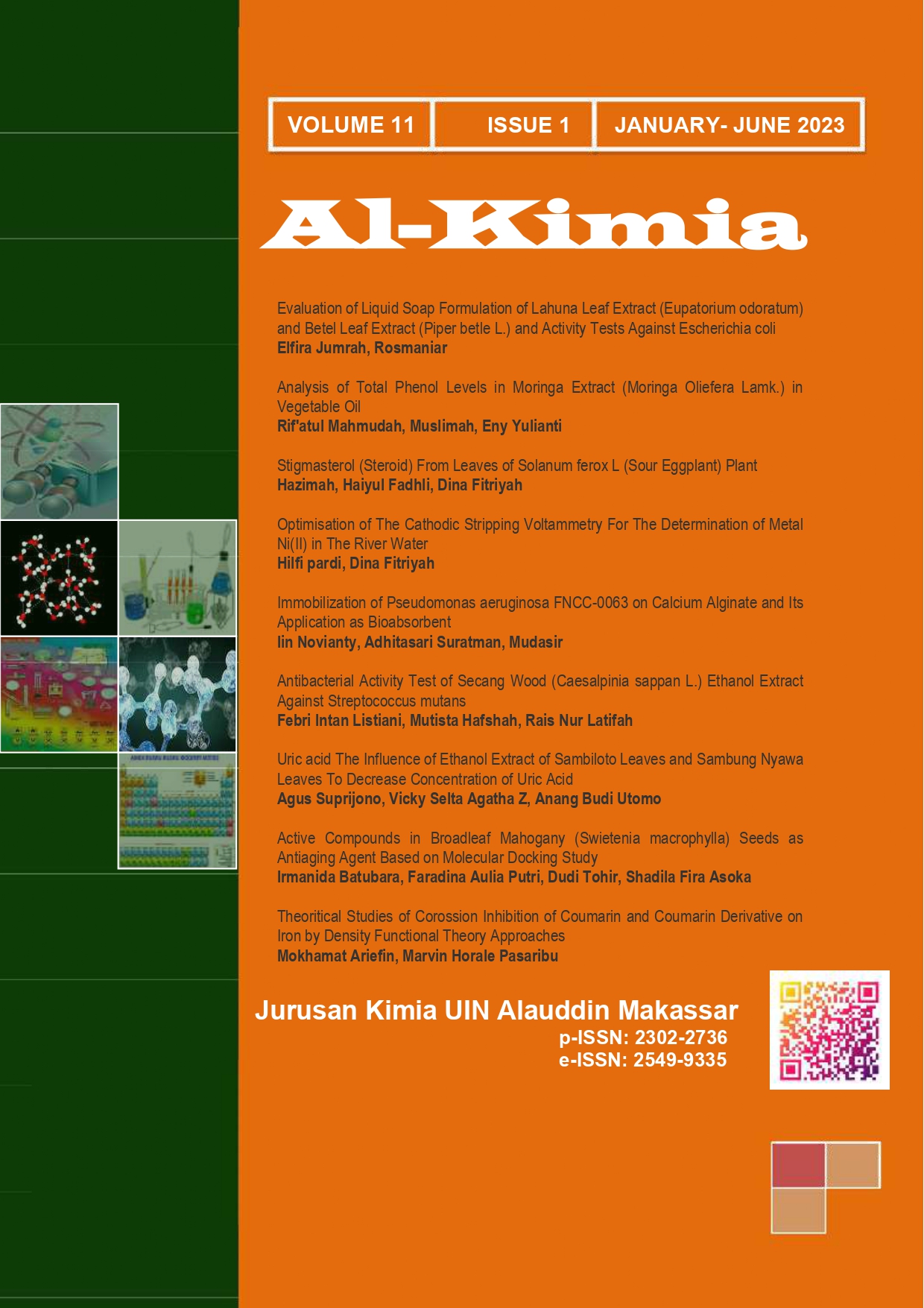Theoritical Studies of Corossion Inhibition of Coumarin and Coumarin Derivative on Iron by Density Functional Theory Approaches
Abstract
Corrosion of iron is a persistent problem that affects its structural integrity and durability in various industrial applications. The design of effective corrosion inhibitors is crucial for mitigating aluminum corrosion. In recent years, coumarin derivatives have shown promising potential as corrosion inhibitors for iron due to their unique chemical properties. In this research, we employ density functional theory (DFT) calculations to investigate electrochemical parameters of coumarin derivatives on iron corrosion. Coumarin (a) and its derivative: hymechromone (b), esculetin (c), and scopoletin (d) are analyzed using DFT calculation. Some descriptor is used to identify such as ionisation energy (I), electron affinity (A), EHOMO, ELUMO, Egap, electronegativity ( ), hardness ( ), number of fraction electron transferred ( N). Based on the EHOMO, ELUMO, Egap, electronegativity ( ), hardness ( ), the order of inhibitor potential of coumarin and it derivative is c > d > b > a. However, based on the number of fractional electrons transferred ( N), the potential inhibitor of coumarin and it derivative are c > b > d > a.
Downloads
References
Chen, X., Chen, Y., Cui, J., Li, Y., Liang, Y., & Cao, G. 2021. Molecular dynamics simulation and DFT calculation of “green” scale and corrosion inhibitor. Computational Materials Science, 188, 110229. https://doi.org/10.1016/j.commatsci.2020.110229
Ebenso, E. E., Arslan, T., Kandemirli, F., Caner, N., & Love, I. 2010. Quantum chemical studies of some rhodanine azosulpha drugs as corrosion inhibitors for mild steel in acidic medium. International Journal of Quantum Chemistry, 110(5), 1003–1018. https://doi.org/10.1002/qua.22249
Fiala, A., Boukhedena, W., Lemallem, S. E., Brahim Ladouani, H., & Allal, H. 2019. Inhibition of Carbon Steel Corrosion in HCl and H2SO4 Solutions by Ethyl 2-Cyano-2-(1,3-dithian-2-ylidene) Acetate. Journal of Bio- and Tribo-Corrosion, 5(2), 42. https://doi.org/10.1007/s40735-019-0237-5
Fukui, K. 1982. The Role of Frontier Orbitals in Chemical Reactions (Nobel Lecture). Angewandte Chemie International Edition in English, 21(11), 801–809. https://doi.org/10.1002/anie.198208013
Fukui, K., Yonezawa, T., & Shingu, H. 1952. A Molecular Orbital Theory of Reactivity in Aromatic Hydrocarbons. The Journal of Chemical Physics, 20(4), 722–725. https://doi.org/10.1063/1.1700523
Khalil, S., Al-Mazaideh, G., & Ali, N. 2016. DFT Calculations on Corrosion Inhibition of Aluminum by Some Carbohydrates. International Journal of Biochemistry Research & Review, 14(2), 1–7. https://doi.org/10.9734/IJBCRR/2016/29288
Megahed, M., Abdel Bar, M., Abouelez, E. said, & El-Shamy, A. 2021. Polyamide Coating as a Potential Protective Layer Against Corrosion of Iron Artifacts. Egyptian Journal of Chemistry, 0(0), 0–0. https://doi.org/10.21608/ejchem.2021.70550.3555
Saha, S. Kr., Murmu, M., Murmu, N. C., Obot, I. B., & Banerjee, P. 2018. Molecular level insights for the corrosion inhibition effectiveness of three amine derivatives on the carbon steel surface in the adverse medium: A combined density functional theory and molecular dynamics simulation study. Surfaces and Interfaces, 10, 65–73. https://doi.org/10.1016/j.surfin.2017.11.007
Shahraki, M., Dehdab, M., & Elmi, S. 2016. Theoretical studies on the corrosion inhibition performance of three amine derivatives on carbon steel: Molecular dynamics simulation and density functional theory approaches. Journal of the Taiwan Institute of Chemical Engineers, 62, 313–321. https://doi.org/10.1016/j.jtice.2016.02.010
Wazzan, N. A. 2015. DFT calculations of thiosemicarbazide, arylisothiocynates, and 1-aryl-2,5-dithiohydrazodicarbonamides as corrosion inhibitors of copper in an aqueous chloride solution. Journal of Industrial and Engineering Chemistry, 26, 291–308. https://doi.org/10.1016/j.jiec.2014.11.043
Yadav, M., Kumar, S., Bahadur, I., & Ramjugernath, D. 2014. Corrosion Inhibitive Effect of Synthesized Thiourea Derivatives on Mild Steel in a 15% HCl Solution. In Int. J. Electrochem. Sci (Vol. 9). www.electrochemsci.org
Authors who publish with this journal agree to the following terms:
1) Authors retain copyright and grant the journal right of first publication with the work simultaneously licensed under a Creative Commons Attribution License that allows others to share the work with an acknowledgement of the work's authorship and initial publication in this journal.
2) Authors are able to enter into separate, additional contractual arrangements for the non-exclusive distribution of the journal's published version of the work (e.g., post it to an institutional repository or publish it in a book), with an acknowledgement of its initial publication in this journal.
3)Authors are permitted and encouraged to post their work online (e.g., in institutional repositories or on their website) prior to and during the submission process, as it can lead to productive exchanges, as well as earlier and greater citation of published work (See The Effect of Open Access).


